Introduction
The U.S. jurisdictions will have fewer delegates to the General Conference of The United Methodist Church than they did in 2008. This has affected the representation of women and U.S. people of color as delegates. That’s because the denomination’s membership is growing in Africa, the Philippines and Europe, while membership continues to decline in much of the United Starts.
According to a statistical overview of The United Methodist Church provided by the General Council on Finance and Administration (GCFA), from 2005 to 2009 (most current data), the membership of the U.S. jurisdictions declined from 8,071,938 to 7,772,966, a decrease of 4%. The Central Conferences over the same period of time increased from 3,497,512 to 4,400,510, an increase of 26%.
Furthermore, during that same period, the Central Conferences increased their share of the total membership of The United Methodist Church from 30% to 36%. And, while this has increased the diversity of the General Conference from a global perspective, it has decreased the participation of women and people of color from the United States.
2012 Statistics
- U.S. female representation at the 2012 General Conference is 44%, up from 43% at the 2008 General Conference
- 117 clergywomen delegates represent the five jurisdictions, just five more than the 112 for the 2000 General Conference
- The 20 female delegates of the Western Jurisdiction represent the only jurisdiction where women are in the majority
- For people of color, clergymen and laywomen lost the most representation from the 2008 General Conference to the 2012 General Conference
- People of color delegates have fallen from 173 (2008 General Conference) to 135 (2012 General Conference)
- People of color have 22% of the U.S. delegates at the 2012 General Conference (25% in 2008)
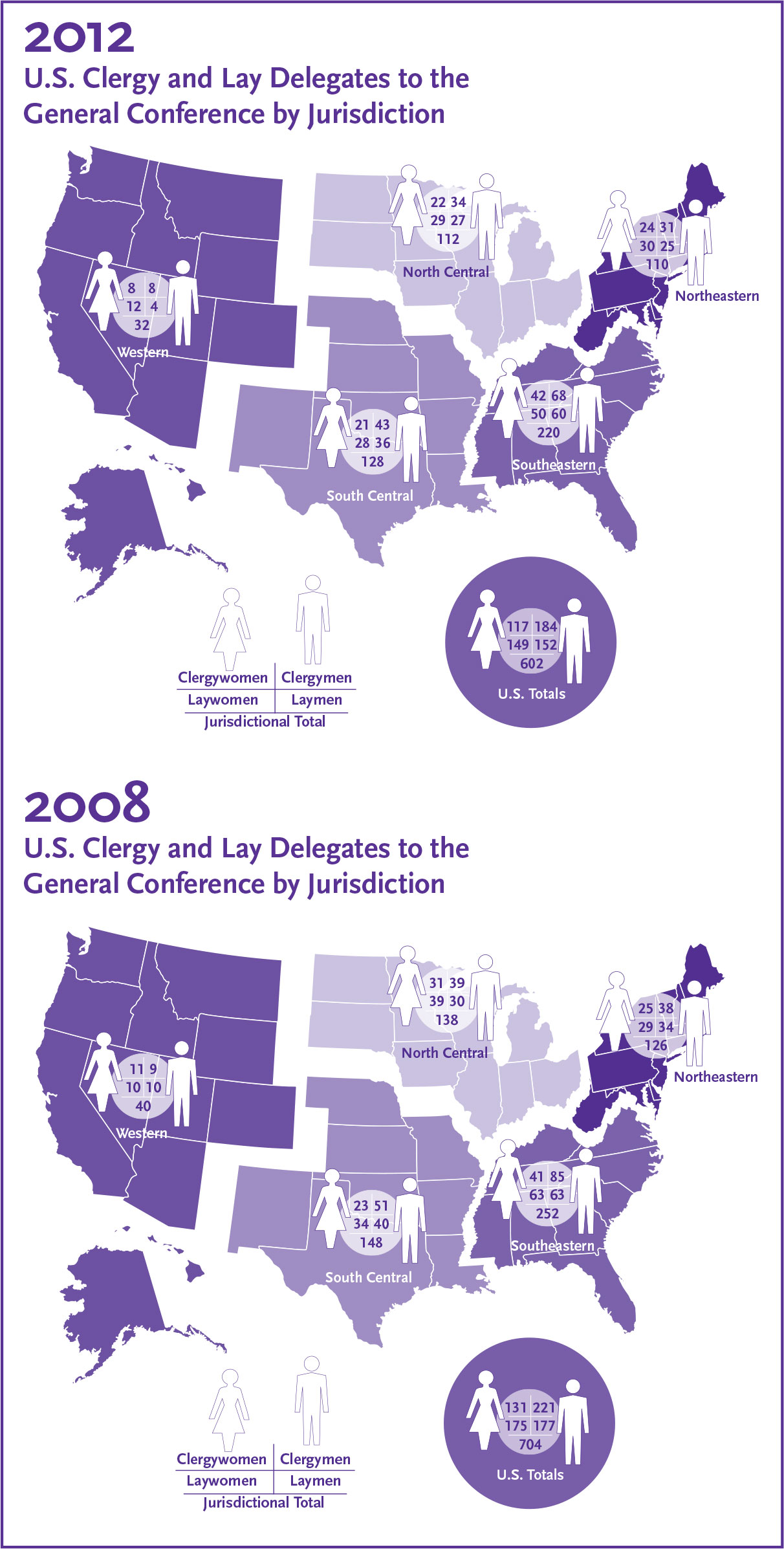
Overall
The number of U.S. female delegates has decreased from 306 (2008 General Conference) to 266 (2012 General Conference), a drop of 40 (see Table 1). During the same time period, the number of U.S. male delegates has decreased from 398 to 336, a decrease of 62 (see Table 1). As a result, these changes have slightly increased the percentage of U.S. female representation at General Conference from 43% (2008 General Conference) to 44% (2012 General Conference). From 2000 to 2012, the female delegates have declined from 324 to 266 delegates, a loss of 58 (18%), while male delegates have dropped from 506 to 336, a loss of 170 (34%).
Yes, all U.S. groups—clergymen, laymen and laywomen—have seen their numbers decrease over time; however, the great impact has been on clergywomen (see Tables 3 , 4 and 5). At 1992 General Conference, 81 clergywomen were delegates and by 2004 General Conference, that number had risen to 137, an all-time high (Table 2). Today, the decrease in clergywomen has reversed all gains over the past 12 years, so that the number of U.S. clergywomen to the 2012 General Conference (117) is almost equal to the 2000 General Conference (112). (Note: clergywomen represent 39% of the clergy delegation while clergywomen make up 24% of all clergy.)
While the number of Central Conference delegates has increased, people of color from the United States has lost representation over the past four years. The number of people of color has dropped from 173 (2008 General Conference) to 135 (2012 General Conference), a loss of 38 or 22%. The 38 persons of color represent 37% of the total loss of 102 persons by the U.S. delegations since 2008 General Conference. Clergymen of color took the biggest loss at 18 persons with people of color laywomen at 15. Clergywomen of color loss is at five persons, but the laymen of color showed no change. Unfortunately, no accurate numbers exist from previous General Conferences to track the impact of decreases on people of color.
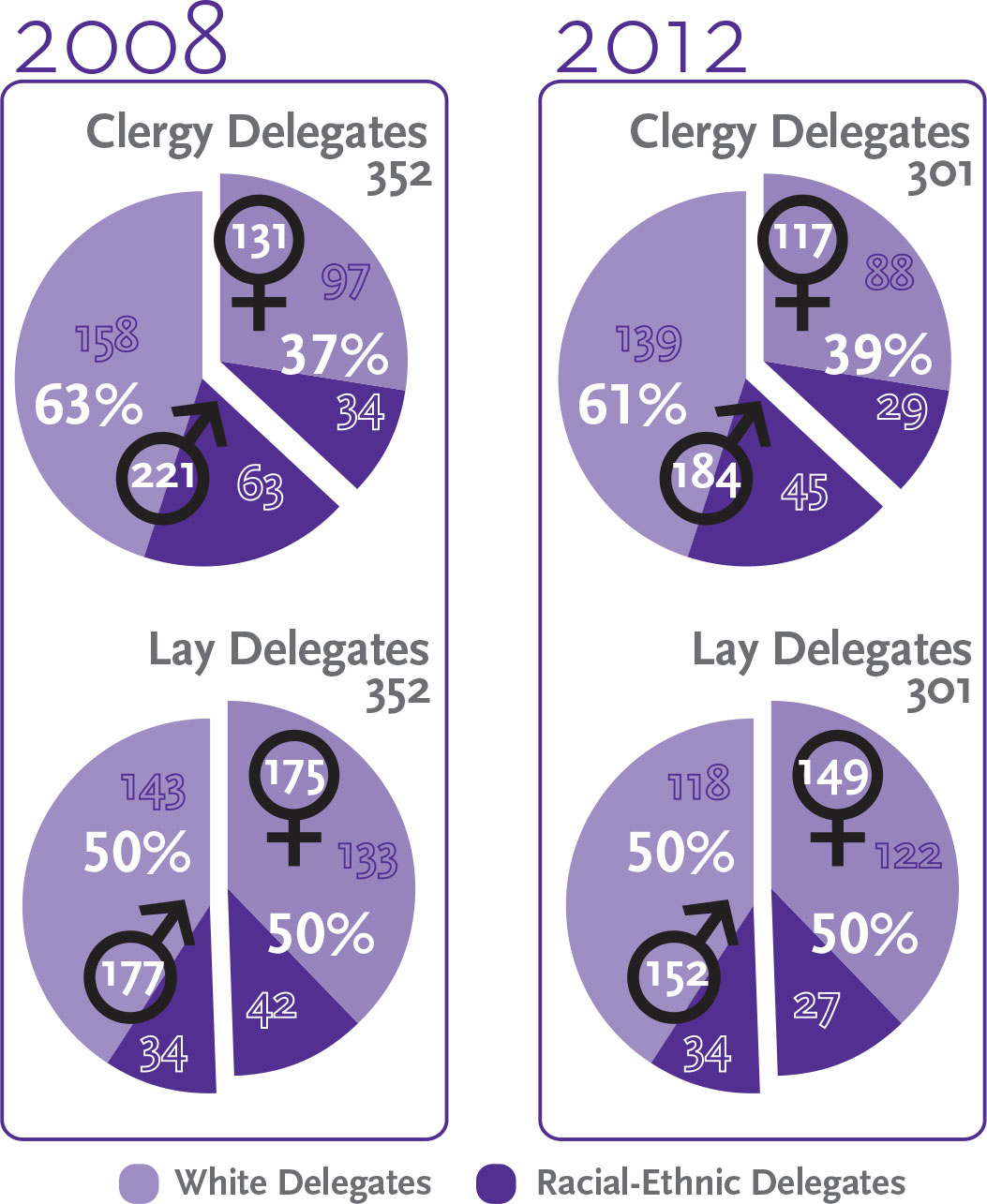
NORTH CENTRAL JURISDICTION
The North Central Jurisdiction dropped its representation from 138 to 112, a loss of 26 or 19% persons from the 2008 General Conference to the 2012 General Conference. Women had their representation decreasing the most with a net loss of 10 laywomen and nine clergywomen. These 19 represent 73% of the total loss of representation by the North Central Jurisdiction (see Tables 3 and 4).
Persons of color had a net loss of 15 representatives from the 2008 General Conference to the 2012 General Conference. They followed the national trend with laywomen and clergymen suffering the greatest losses. Persons of color saw their numbers almost cut in half from 33 to 18 in the North Central Jurisdiction. Consequently, their share of the overall jurisdictional representation fell from 24% to 16% (see Tables 3 and 4).
NORTHEASTERN JURISDICTION
The Northeastern Jurisdiction dropped its membership from 126 to 110, a loss of 16 or 13%. The female representation showed no net change staying at 54 delegates. The Northeastern Jurisdiction had a net increase of one laywoman and a net decrease of one clergywoman. The 54 delegates represent 49% of the total delegation (see Tables 3 and 4).
Persons of color also showed no net change. They had a net increase of four laity and a net decrease of four clergy. Clergymen lost three persons and laymen gained three persons. By holding their own, persons of color actually saw their total representation increase from 29% to 32% of the Northeastern Jurisdiction (see Tables 3 and 4).
SOUTH CENTRAL JURISDICTION
The South Central Jurisdiction dropped its representation from 148 to 128, a loss of 20 or 14%. The female representation had a net loss of eight members (two clergywomen and six laywomen). The two clergywomen were both women of color, but only one of the six laywomen was a woman of color. Women delegates make up 38% of the South Central Jurisdiction, a one percentage point drop from the 39% at the 2008 General Conference (see Tables 3 and 4).
Persons of color had a net loss of seven delegates from 2008 to 2012. Clergymen, clergywomen and laymen had a net loss of two persons each. Persons of color fell from 35 to 28 delegates. Consequently, their representation dropped from 24% to 22% of the delegation (see Tables 3 and 4).
SOUTHEASTERN JURISDICTION
The number of Southeastern delegates fell from 252 to 220, a loss of 32 or 13%. Clergywomen had a net increase of one representative while laywomen had a net decrease of 13 delegates. In actuality, the Southeastern Jurisdiction added two women of color clergy. Women have 92 delegates or 42% of the Southeastern delegation (see Tables 3 and 4).
The number of persons of color dropped from 52 to 42, a loss of 10 or 19%. The loss of 10 persons represents one-third of the total delegation loss from 2008 to 2012. Clergymen dropped eight representatives and laywomen dropped seven representatives, which were offset by the gains of laymen and clergywomen. People of color make up 19% of the Southeastern Jurisdiction delegation (see Tables 3 and 4).
WESTERN JURISDICTION
The Western Jurisdiction number of delegates fell from 40 to 32, a loss of 8 or 20%. Females lost one delegate from 2008 to 2012 with clergywomen showing a net loss of three, while laywomen showed a net increase of two. Nevertheless, women make up 21 or 66% of the Western delegation, the only jurisdiction in which women have a majority of delegates (see Tables 3 and 4).
Persons of color had a net loss of six persons, from 17 to 11. Clergywomen and laywomen had a net loss of two persons each while laymen and clergymen had a net loss of one person each. The decrease in persons of color from 17 to 11 saw their representation fall from 43% to 34% (see Tables 3 and 4).
Table 1
Gender of Delegates by Jurisdiction
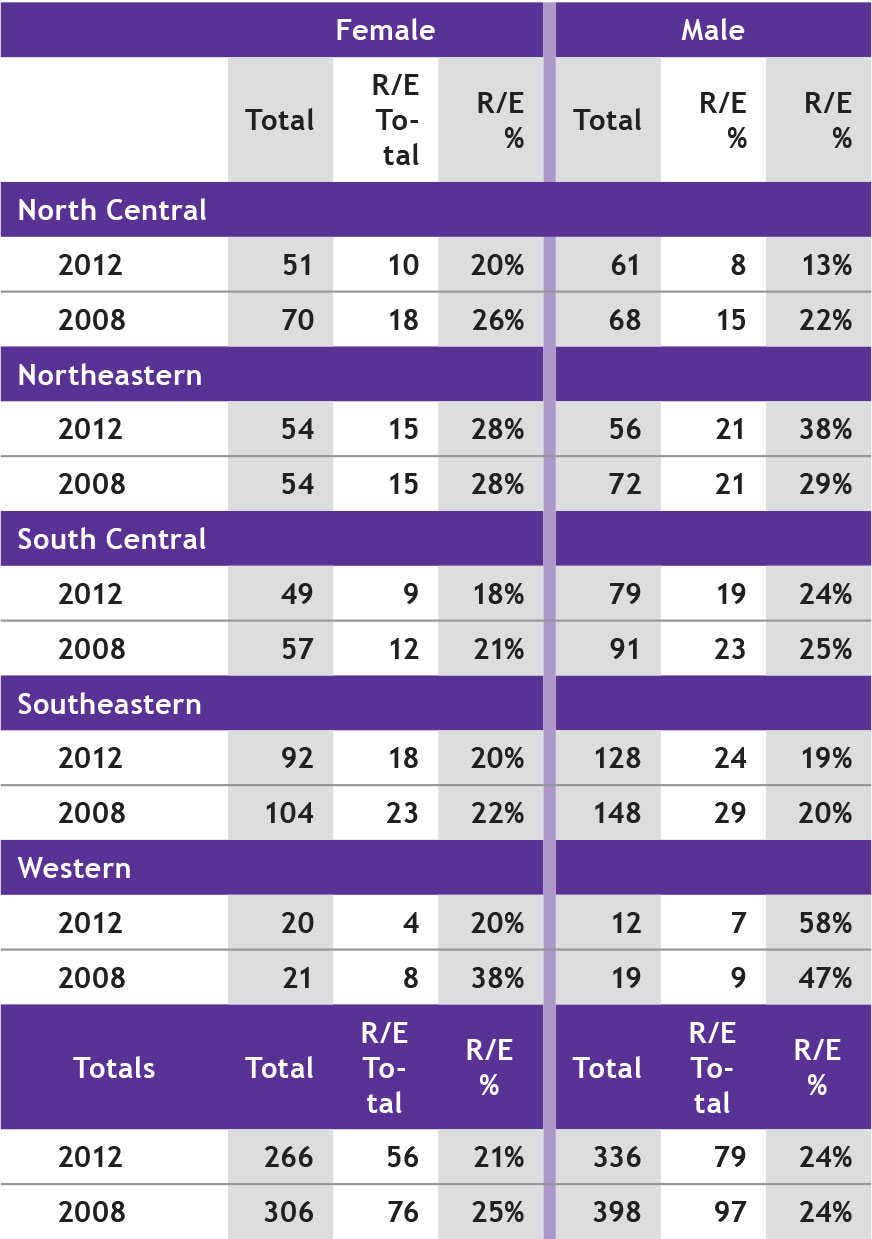
Table 2
Clergy and lay female delegates by General Conference
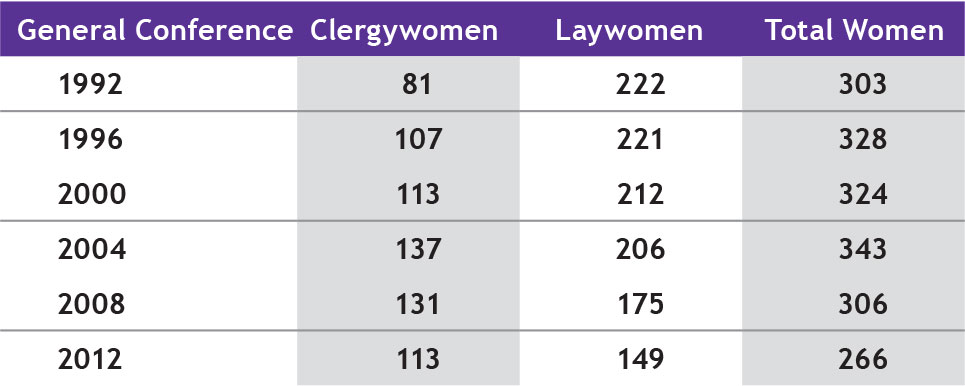
Table 3
Gender and Persons of Color Clergy by Jurisdiction and General Conference
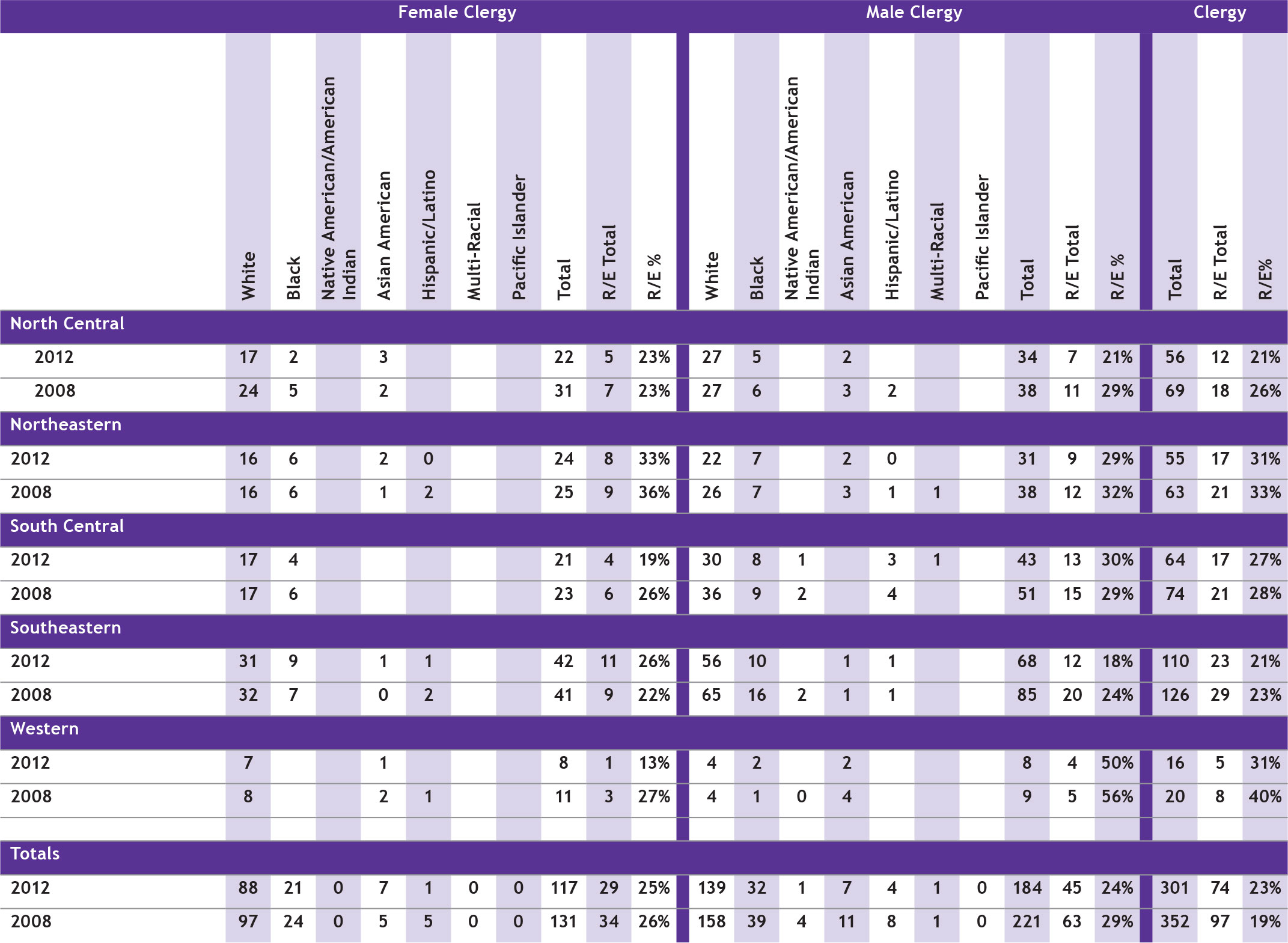
Table 4
Gender and Persons of Color Laity by Jurisdiction and General Conference
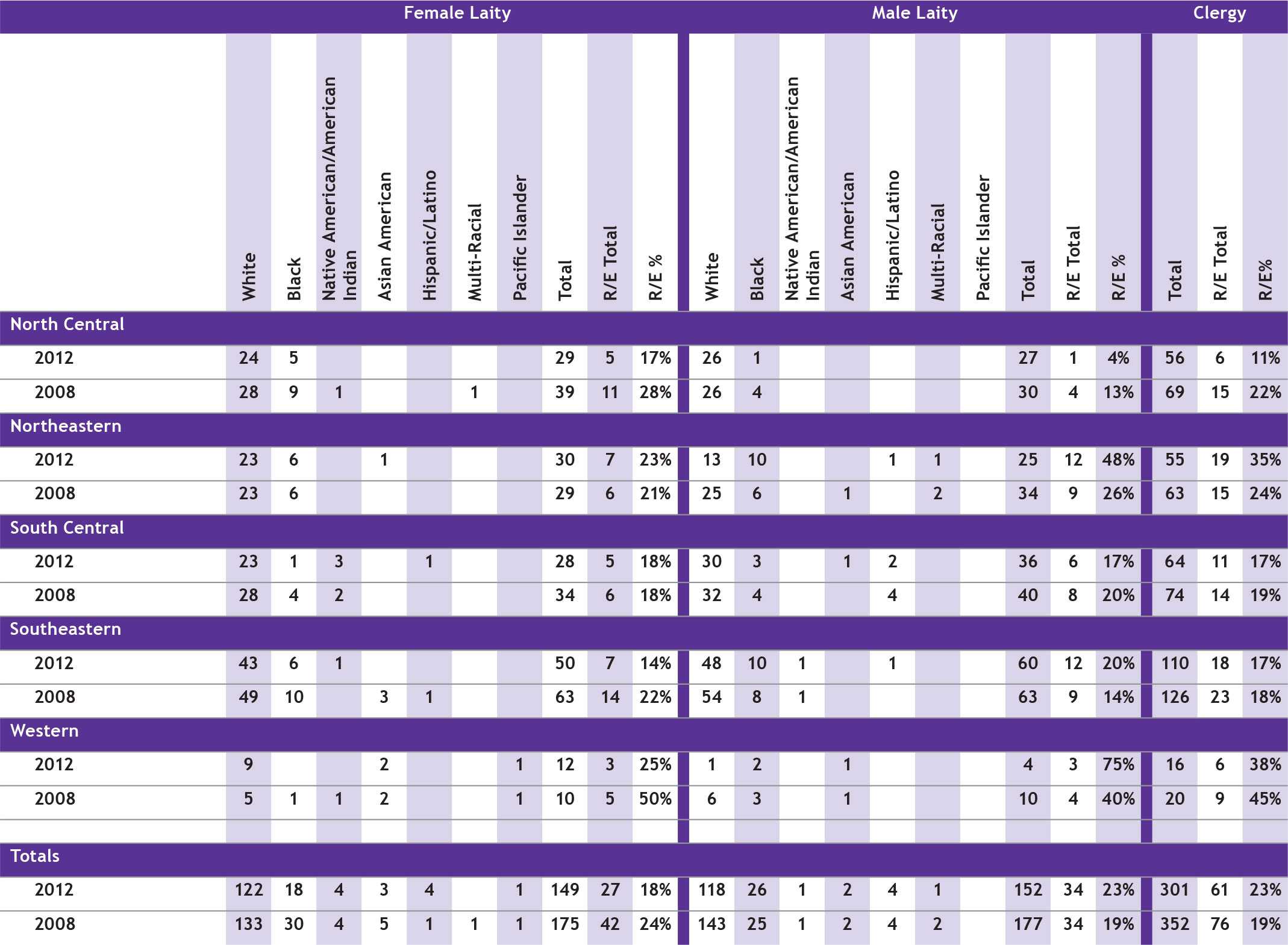
Conclusion
As the United Methodist denomination continues to grow globally, the challenge for the U.S. United Methodists is to remain inclusive while its membership (and thus General Conference representation) gets smaller. Just because the U.S. delegations and representation are getting smaller, the decrease does not have to rest on the backs of women and people of color. Yes, the U.S. United Methodist Church is over 90% white, but the representation at General Conference—the highest decision-making body of the church — needs to be more than white. The United States — our mission field — is 35% people of color and growing. For The United Methodist Church in the U.S. to become the body of Christ, we need to become the inclusive and diverse church.
